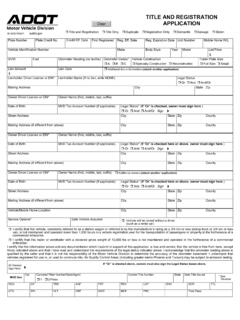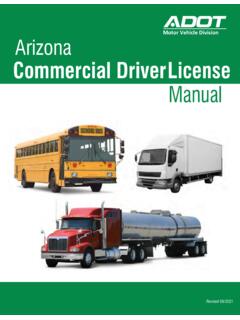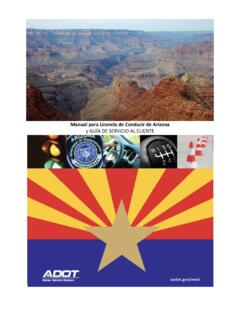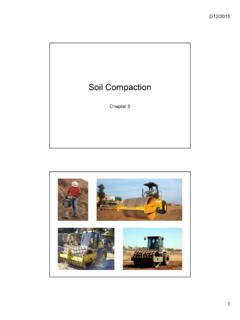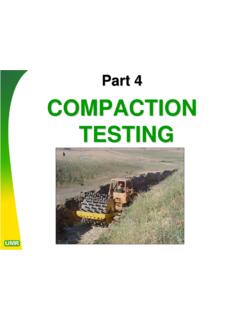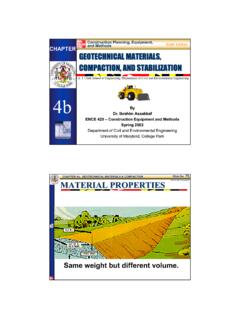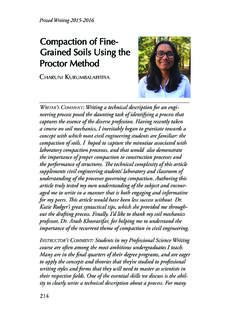Transcription of MAXIMUM DRY DENSITY AND OPTIMUM MOISTURE OF …
1 ARIZ 245a December 4, 2015 (14 Pages) MAXIMUM DRY DENSITY AND OPTIMUM MOISTURE OF SOILS BY proctor ALTERNATE METHOD D (A Modification of AASHTO Designation T 99) 1. SCOPE This test method describes the procedure for determining the MAXIMUM dry DENSITY and OPTIMUM MOISTURE content for a soil by the proctor Alternate Method D. Alternate Method D may be used for all MAXIMUM dry DENSITY and OPTIMUM MOISTURE content determinations except for volcanic cinders or light porous material on which the specific gravity cannot be determined with consistency or when the MOISTURE absorption for the coarse aggregate is greater than Alternate Method D may be used except when greater than 40% of the material is retained on the 3/4 inch sieve. An example is provided in Figure 2 for the calculations and determinations referenced herein. This test method may involve hazardous materials, operations, and equipment.
2 This test method does not purport to address all of the safety problems associated with its use. It is the responsibility of whomever uses this test method to consult and establish appropriate safety and health practices and determine the applicability of regulatory limitations prior to use. 2. APPARATUS Requirements for the frequency of equipment calibration and verification are found in Appendix A3 of the Materials Testing Manual. 6 inch proctor mold having a capacity of approximately 1 cubic foot, with an internal diameter of plus or minus inches and a height of ARIZ 245a December 4, 2015 Page 2 plus or minus inches. The mold shall have a nominal wall thickness of 1/4 inch. It shall be equipped with an extension collar approximately 2 3/8 inches high. A baseplate as shown in Figure 1 shall be provided. A hand or mechanical rammer weighing pounds, having a flat face, and equipped with a suitable arrangement to control the height of drop to a free fall of 12 (1/16) inches above the elevation of the soil.
3 The hand rammer face shall be circular with a diameter of plus or minus inches. The mechanical rammer face shall have the shape of a piece of pie, with a radius of approximately 3 inches, and having an area of square inches. If a mechanical apparatus is used, it must be monitored through the ADOT proficiency sample program and maintain a rating of 3 or better based on the results of testing ADOT and AMRL proficiency samples. Hardened steel straightedge, at least 10 inches in length. It shall have one beveled edge, and at least one longitudinal surface (used for final trimming) shall be plane within inch per 10 inches ( percent) of length with the portion used for trimming the soil. Scale or balance capable of measuring the MAXIMUM weight to be determined, accurate to at least one gram. Scale or balance capable of measuring the MAXIMUM weight to be determined, accurate to at least gram.
4 Oven capable of maintaining a temperature of 230 9 F. 3/4 inch and 3 inch sieves conforming to the requirements of AASHTO M 92. Miscellaneous mixing tools and pans. Sample Extruder (optional) consisting of a jack, lever, frame, or other device for extruding the compacted sample from the mold. 3. CALIBRATION OF MOLD Molds shall be calibrated in accordance with APPENDIX A of Arizona Test Method 225. ARIZ 245a December 4, 2015 Page 3 4. SAMPLE Enough soil material shall be provided from the field to make five compacted specimens. A minimum sample size of 45,000 grams (approximately 100 lbs.) is normally required. If the soil sample is damp when received from the field, dry it until it becomes friable under a trowel. Drying may be in air or by use of a slow fan or other drying apparatus such that the temperature of the sample does not exceed 140 F. Thoroughly break up the aggregations in such a manner as to avoid reducing the natural size of individual particles.
5 Weigh out an approximate 45,000 gram sample of representative soil. Record the weight of the sample, and sieve the material over a 3/4 inch sieve. If the percentage of coarse aggregate or rock retained on the 3/4 inch sieve is not already known from gradation testing, save any material retained on the 3/4 inch sieve and weigh. Calculate the percent of coarse aggregate or rock particles retained on the 3/4 inch sieve according to the following equation: WR3/4 PR3/4 = x 100 WT Where: PR3/4 = Percentage of coarse aggregate or rock particles retained on the 3/4 inch sieve WR3/4 = Weight of coarse aggregate or rock particles retained on the 3/4 inch sieve WT = Total weight of material sieved If "PR3/4" is greater than 40%, then too much rock is present to allow for a reasonable MAXIMUM dry DENSITY determination If "PR3/4" is less than or equal to 40%, blend material passing the 3/4 inch sieve thoroughly and proceed to Section 5 of this test method.
6 If a specific gravity and absorption determination, in accordance with AASHTO T 85, is to be made for the plus 3/4 inch material, save an adequate amount of this material, otherwise, discard it. ARIZ 245a December 4, 2015 Page 4 5. PROCEDURE From the thoroughly blended passing 3/4 inch material from Subsection , split out 5 representative approximate 5000 gram samples. Select one sample and thoroughly mix with sufficient water to dampen it to approximately three percentage points below OPTIMUM MOISTURE content. Note: If desired, an additional three samples may be mixed at this time with approximate MOISTURE contents of 1% below OPTIMUM , 1% over OPTIMUM , and 3% over OPTIMUM . The MOISTURE in each of these samples shall be retained by covering with a damp cloth or being sealed in air tight containers until they are compacted. One of the five samples should be retained for future use since it is necessary to have at least two points defined on each side of the MOISTURE DENSITY curve.
7 Heavy clay soils or materials which tend to break down, or those in which it is difficult to incorporate water, shall require approximately 12 hours for uniform MOISTURE absorption to be achieved. This shall be accomplished by preparing separate samples for each increment of water to be added, and then placing and sealing these samples in air tight containers for the 12 hour period. Form a specimen by compacting the prepared soil in the six inch mold (with extension collar attached) in three equal layers to give a total compacted depth of about 5 inches. Compact each layer with 56 uniformly distributed blows from the rammer, dropping free from a height of 12 inches. While each layer is being compacted, the remainder of material shall be in a pan covered by a damp cloth. During compaction, the mold shall rest firmly on a dense, uniform, rigid and stable foundation. Note: Each of the following has been found to be a satisfactory base on which to rest the mold during compaction of the soil: A block of concrete, weighing not less than 200 lbs.
8 , supported by a stable foundation; a sound concrete floor; and for field application, such surfaces as found in concrete box culverts, bridges, and pavements. When compacting granular, free draining materials, at MOISTURE contents which are at or above OPTIMUM , the mold shall be prepared by first sealing the bottom ARIZ 245a December 4, 2015 Page 5 of the mold with waterproofing grease. All excess grease shall be wiped from the mold and baseplate. Following compaction, carefully remove the extension collar. It may be necessary to use a follower to retain the soil in the mold while removing the collar to prevent damage or disturbance of the soil below the top of the mold. Carefully trim the compacted soil even with the top of the mold by means of the straightedge. If any voids are created during trimming, these shall be filled with fine material and smoothed off. Determine the weight of compacted specimen and mold.
9 Determine the wet DENSITY , "WD", of the compacted soil by the following: M1 M2 WD = VM x (grams/lb.) Where: WD = Wet DENSITY of compacted soil, ft. M1 = Weight of compacted specimen and mold, grams M2 = Weight of the mold, grams VM = Volume of the mold, cu. ft. (See Section 3 of this procedure.) The estimated dry DENSITY , "ED", of the compacted soil may be calculated and recorded to the nearest ft. as follows: WD ED = x 100 (Approx. % of water added) + 100 Where: ED = Estimated dry DENSITY of compacted soil, ft. WD = Wet DENSITY of compacted soil, ft. Note: These estimated densities are approximate only and will be corrected when final MOISTURE results are obtained. The estimated dry DENSITY is useful in deciding how much water to add in later trial batches, if the procedure described in the note following Subsection , for initially preparing three additional samples with varying MOISTURE contents is not utilized.
10 By carefully observing the estimated dry DENSITY of the compacted ARIZ 245a December 4, 2015 Page 6 samples, the operator should be able to vary the MOISTURE content as the test proceeds so that when the final MOISTURE DENSITY results are plotted, a curve will result that rises to a peak and then falls away. Remove the material from the mold and slice vertically through the center. Take a representative minimum 600 gram sample from the full length and width of one of the cut faces. Weigh immediately, and dry to a constant weight in an oven at 230 9 F to determine the MOISTURE content in accordance with AASHTO T 265. Record the weight of wet soil to the nearest gram as "WW", and record the weight of oven dry soil to the nearest gram as "DW". For granular, free draining materials, the MOISTURE content shall be determined using the entire compacted proctor specimen. Determine the weight of wet soil, "WW", by subtracting the weight of the mold, "M2", from the weight of compacted specimen and mold, "M1".
